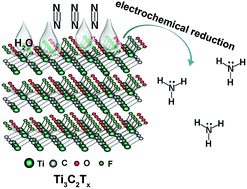Ti3C2Tx (T = F, OH) MXene nanosheets: conductive 2D catalysts for ambient electrohydrogenation of N2 to NH3†
Abstract
The Haber–Bosch process for industrial-scale NH3 production suffers from high energy consumption and serious CO2 emission. Electrochemical N2 reduction is an attractive carbon-neutral alternative for NH3 synthesis but is severely restricted due to N2 activation needing efficient electrocatalysts for the N2 reduction reaction (NRR) under ambient conditions. Here, we report that Ti3C2Tx (T = F, OH) MXene nanosheets act as high-performance 2D NRR electrocatalysts for ambient N2-to-NH3 conversion with excellent selectivity. In 0.1 M HCl, such catalysts achieve a large NH3 yield of 20.4 µg h−1 mgcat.−1 and a high faradic efficiency of 9.3% at −0.4 V vs. reversible hydrogen electrode, with high electrochemical and structural stability. Density functional theory calculations reveal that N2 chemisorbed on Ti3C2Tx experiences elongation/weakness of the N![[triple bond, length as m-dash]](https://www.rsc.org/images/entities/char_e002.gif) N triple bond facilitating its catalytic conversion to NH3 and the distal NRR mechanism is more favorable with the final reaction of *NH2 to NH3 as the rate-limiting step.
N triple bond facilitating its catalytic conversion to NH3 and the distal NRR mechanism is more favorable with the final reaction of *NH2 to NH3 as the rate-limiting step.

- This article is part of the themed collection: 2018 Journal of Materials Chemistry A HOT Papers


 Please wait while we load your content...
Please wait while we load your content...